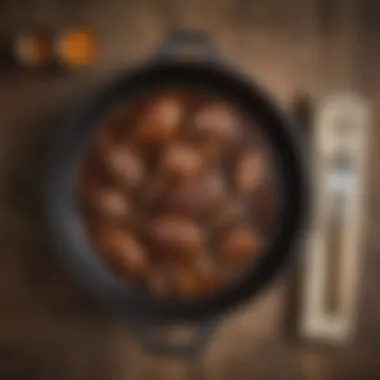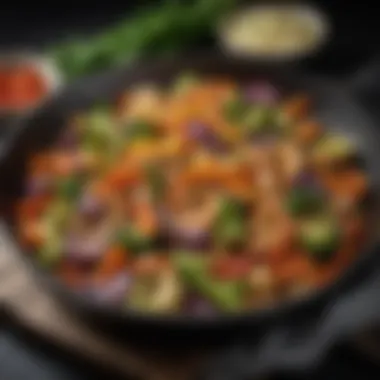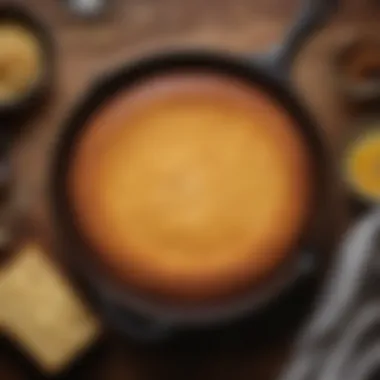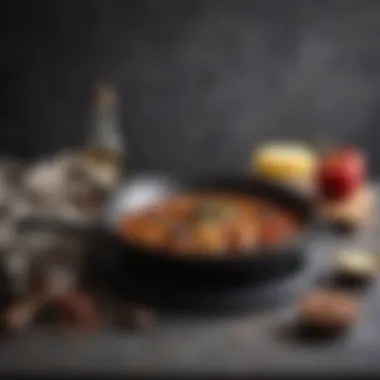Unlocking Culinary Potential: The 12-Inch Cast Iron Skillet


Intro
The 12-inch cast iron skillet has long been a staple in kitchens around the world. Its enduring popularity stems from its unique thermal properties, which allow for even heat distribution and excellent heat retention. Beyond its functionality, it embodies timeless craftsmanship that transcends modern cookware trends. For busy individuals and families, making informed decisions about the tools utilized in their culinary routines can significantly impact both efficiency and flavor.
This article explores the multifaceted applications of the 12-inch cast iron skillet—from mastering simple recipes to utilizing it for intricate dishes. In focusing on practical advice related to maintenance, usage techniques, and recipe ideas, this narrative endeavors to equip readers with the necessary knowledge to unlock the skillet’s potential.
Recipe Highlight
Let’s begin with an enticing recipe that showcases the versatility of a cast iron skillet: Garlic Butter Shrimp and Broccoli.
Essential Ingredients:
- 1 pound of shrimp, peeled and deveined
- 2 cups of broccoli florets
- 4 cloves of garlic, minced
- 1/4 cup of butter
- 1 teaspoon of red pepper flakes
- Salt and pepper to taste
Preparation Time: Approximately 20 minutes
Servings: Serves 4
Step-by-Step Instructions
- Prepare the ingredients: Before you start cooking, ensure that all necessary ingredients are ready. This cuts down on prep time.
- Heat the skillet: Place the 12-inch cast iron skillet on medium heat and add the butter until melted. Ensure it coats the bottom evenly for best cooking results.
- Cook the broccoli: Add the broccoli florets to the skillet and cook for about 2-3 minutes until slightly tender.
- Add garlic and shrimp: Incorporate the minced garlic and red pepper flakes, cooking for another minute. Then, add the shrimp to the skillet. Sauté until the shrimp turns pink and opaque, approximately 3-5 minutes.
- Season: Finally, season the dish with salt and pepper to taste. Give everything a gentle mix and allow it to cook for an extra minute.
- Serve: Transfer the mixture into a serving dish, or present directly from the skillet for an inviting table setting.
Note: Avoid overcrowding the skillet to ensure shrimp cooks evenly. Always preheat properly.
Variations and Substitutions
To customize this recipe, consider:
- Replacing shrimp with chicken breast or tofu for varied protein options.
- Adding cherry tomatoes for an extra burst of flavor.
- Using ghee or neutral oil instead of butter for a dairy-free alternative.
Diverse sides, such as quinoa or a fresh salad, complement this dish beautifully, enhancing your meal's nutritional profile.
Time-Saving Cooking Tips
- Consider prepping your ingredients the night before. Chop broccoli and garlic ahead of time and store them in airtight containers.
- Use a vegetable chopper for quick cutting; it can save significant preparation time.
- Cook a larger batch and refrigerate any leftovers for quick reheating throughout the week.
Nutritional Information
- Calories per Serving: Approximately 250 calories
- Key Nutrients: Each serving provides a good source of protein and fiber, along with vitamins A and C from the broccoli.
- Diet Suitability: This dish is adaptable for keto and paleo diet plans. By substituting certain ingredients, it can fit on gluten-free and dairy-free diets as well.
Exploring the capabilities of your 12-inch cast iron skillet opens doors to many culinary moments. Capitalizing on its thermal properties and versatility provides a memorable cooking experience that resonates not just with the food but with family at the dining table.
Prologue to Cast Iron Cookware
Cast iron cookware, especially the skillet, holds a special place in culinary arts. Its importance stems from its excellent ability to conduct and retain heat. This characteristic allows for various cooking techniques, from frying to baking. Understanding cast iron equipment is essential for both novice and seasoned cooks. More importantly, it goes beyond just practicality; it's also about tradition and craftsmanship. Each piece carries a history, often handed down through generations.
Historical Significance
Historically, cast iron skillets are associated with various cultures. Originating in China during the Han Dynasty, these skillets really became a staple in Europe in the 18th century. They were made available to the masses due to affordability and practical applications. Through time, cast iron represented resilience and durability. Many families cherish their skillets as heirlooms, emphasizing their cultural worth. This multifaceted history enhances their value today. Cast iron skillets not only perform well but also conbvey a sense of heritage. This connection with history can enrich the cooking experience.


Understanding Cast Iron Material
Cast iron is a type of iron alloy containing carbon. This composition is pivotal. The element carbon improves the metal's ability to retain heat. Unlike other metals, cast iron is particularly thick, aiding in even heat distribution. For cooks, this means a unified temperature throughout the cooking surface. Also, an important fact is the seasoning process of cast iron. It refers to coating the surface with oils to form a natural non-stick layer. The clarity of this material defines why many evaluate it highly. Understanding materials can sometimes seem technical, but it significantly influences cooking results.
The level of care and maintenance invested speaks to the culinary results achieved. This makes cast iron not just a tool but a companion in the kitchen.
The 12-Inch Cast Iron Skillet
The 12-inch cast iron skillet stands as an essential tool in the kitchen. Its size makes it versatile for many cooking tasks. This skillet strikes a balance between being large enough to prepare meals for families while still being manageable to handle. Within the realm of cast iron cookware, the significance of this skillets unfolds when considering its design, functionality, and adaptability.
Dimensions and Design
A 12-inch cast iron skillet typically has a diameter of 12 inches with a slightly thicker base. This thickness provides excellent heat retention and distribution. The design often incorporates high, sloped sides which are helpful for tasks such as sautéing, frying, or even baking. The appearance of a cast iron skillet can be rustic yet sophisticated, appealing to those who appreciate traditional cooking methods.
Spacious enough for multiple pieces of chicken or vegetables, this size allows for preparing family dinners or meals for guests. The even heating reduces the concern of hot or cold spots, thus more reliable cooking outcomes can be achieved. Furthermore, the materials seem aesthetic, contributing to a well-decorated kitchen space, sometimes even serving directly as a serving dish.
Weight and Handle Considerations
Weight is a important aspect to tackle when considering a 12-inch skillet. Generally, a cast iron skillet weighs between 5 to 8 pounds. Depending on personal strength and comfort level, this weight might be manageable for some while a bit challenging for others. Hence, evaluating one's own physical capability is key and to understand how it will fit into your daily cooking habits.
The handle on a the skillet varies in style, but a well-designed handle provides a secure way to grip. Many skillets have a short helper handle on the opposite side. This design feature allows for better support when moving or pouring from the skillet. The bonus is that handles, in many cases, are crafted to stay cool, though precautions must still be taken.
Advantages of Using a 12-Inch Cast Iron Skillet
Using a 12-inch cast iron skillet offers multiple benefits, making it an invaluable tool in many kitchens. Its unique properties enhance cooking techniques and outcomes, enabling everyone from novice cooks to seasoned chefs to achieve flavorful results. Understanding these advantages can shape one’s culinary practices and increase overall efficiency in meal preparation.
Retains Heat Effectively
One of the standout features of the 12-inch cast iron skillet is its excellent heat retention. Once heated, it holds warmth for an extended period. This capacity allows for even cooking, preventing hot or cold spots. When frying or searing meats, a consistently hot surface facilitates browning, adding depth to flavors. This effectiveness means less flipping or rearranging is needed, leading to a confident cooking experience.
Versatile Cooking Options
This skillet excels in numerous cooking methods, making it a multifaceted kitchen companion. In a 12-inch cast iron skillet, you can easily transition between different techniques.
Frying
Frying in a cast iron skillet provides a specific, direct heat that merges well with oils, achieving a sought-after crispy finish. The ability to maintain high temperatures keeps the food from absorbing too much oil, resulting in lighter fried foods. This is why frying is viewed as a beneficial method when utilizing this skillet. However, care must be taken not to overcrowd the pan, as that may lower the cooking temperature.
Baking
Baking in a 12-inch skillet often leads to delightful textures. Recipes such as cornbread or skillet pizza yield a uniquely crispy edge, while moist insides emerge from careful baking. The heat distribution enriches flavors since the cast iron gradually releases heat back into the food. Thus, baking is recognized as a superb choice in many culinary applications.
Roasting
Roasting with a cast iron skillet can transform your vegetables and proteins brilliantly. Its capacity to withstand high oven temperatures allows meats to sear beautifully and veggies to caramelize. This process not only intensifies the flavors but ensures a cohesive cooking experience. Therefore, roasting in your skillet takes advantage of its efficiency and effectiveness.
Grilling
Grilling using a cast iron skillet excels when outdoor grilling is not feasible. It achieves attractive grill marks and maintains necessary high heat for cooking meats. A well-heated skillet efficiently transcends indoor culinary limits without requiring special equipment. Grilling, therefore, is a strong choice for any indoor cook, ensuring many dishes can be cooked with authenticity.
Durability and Longevity


The durability of a cast iron skillet cannot be overstated. These skillets can endure the rigors of daily cooking, often surpassing expectations for longevity. With the proper care, such as regular seasoning, a cast iron skillet is capable of lasting generations. This resilience to wear and usage solidifies its value as a kitchen investment. Also, their timeless construction contributes to various features. For example, scratches or surface wear can often be rehabilitated by following simple maintenance guidelines. Thus, durability and longevity play essential roles in the allure and practicality of the 12-inch cast iron skillet.
Comparison with Other Cookware
Understanding the unique benefits of using a 12-inch cast iron skillet necessitates comparing it with other popular cookware materials. Lifestyle dynamics, cooking preferences, and dish requirements may dictate the choice of cookware. Each material serves vital functions in kitchen use, thus talent lies in selecting the right tool for each cooking task at hand.
Stainless Steel
Stainless steel cookware is favored for its durability and resistance to corrosion. Many chefs value its non-reactive properties, which is especially important when preparing acidic food items like tomatoes or citrus-based dishes. Unlike cast iron, stainless steel does not retain heat as effectively, leading to heat dispersion through cooking processes. This can result in uneven cooking if not monitored closely. While a 12-inch cast iron skillet excels at consistent heat retention, a stainless steel skillet cools quickly, ideal for sautéing vegetables or searing meats that require precise temperature control.
In terms of care, maintaining stainless steel is generally easier. The smooth surface avoids food sticking issues, but may require harsher cleaning methods compared to cast iron. It is treated with various finishes for additional ease and durability. Using stainless steel might suit specific cooking styles or preferences, although versatility diminishes when trying to replicate the flavors brought out by a cast iron lover’s touch.
Non-Stick Options
Non-stick cookware provides convenience, especially with delicate cooking tasks like frying eggs or preparing pancakes. The coated surfaces ease the aftermath of cooking and the subsequent cleaning process. However, this advantage comes with conditions; the lifespan of non-stick surfaces depends on careful usage, as heating them too high can damage their properties. Unlike the 12-inch cast iron skillet, which can withstand high heats and improve with age through proper seasoning, non-stick applications wear away over time.
Minimizing the versatility of these options becomes clear when observing their performance in various cooking styles, particularly those involving prolonged heat, like baking or deep frying. A seasoned cast iron skillet develops a natural non-stick property that enhances over time, yielding delightful results in taste and texture.
To conclude, each type of cookware brings specific requirements dictated by user preferences and dish types. A blend of essential principles can refine the decision-making route for identifying the best equipment to elevate those kitchen experiences. Given this comparison, exploration into your cooking preference can unveil deeper routes between cookware cohesion and the art of crafted meals.
Choosing the Right 12-Inch Cast Iron Skillet
Choosing the right 12-inch cast iron skillet is critical for anyone looking to fully benefit from this versatile kitchen tool. A cast iron skillet can greatly impact cooking performance, flavor, and even health when used properly. Models may vary significantly, resulting in differences that can enhance or hinder cooking results.
Considerations include material quality, weight, and cleaning paths. Factors such as durability and cooking surface play a pivotal role in your overall experience. Moving away from broader generalizations helps narrow down what works best for individual needs or cooking styles.
The quality of your cast iron skillet can influence not just ease of use, but the flavors produced in your meals.
What to Look For
When hunting for a 12-inch cast iron skillet, a few elements stand out. Brand reputation matters, where established names often come with customer reviews highlighting their product's efficacy. Weight shouldn’t be overlooked. Heavier skillets tend to retain heat better, making them perfect for searing meats and holding heat, while lighter options may be easier to maneuver.
Surface finish is another. Look for skillets with a smooth surface for better seasoning and food release. Handle design is crucial too, ensuring a firm grip when someone must transition the skillet from stovetop to oven. A good skillet will also have a pour spout making it easier to manage liquids and drippings when cooking
- Look for these key features:
- Quality of material
- Appropriate weight
- Smooth cooking surface
- Ergonomic handle design
- Pour spout present
Brands to Consider
Not all brands are created equal, and choosing wisely can make a tremendous difference in experience. Lodge, for instance, is highly esteemed for its affordability and remarkable quality. The company's cast iron skillets are often pre-seasoned and are backed by generations of experience in craftsmanship.
Another noteworthy brand is Le Creuset, famed not only for unique enameled options but also for longevity and style, ensuring your skillet shines both in cooking performance and kitchen aesthetics.
Cuisinart also deserves mention, offering skillets with a bit of extra technology for ease of use.
When selecting a brand, take into account your budget and any specific cooking preferences. Try to read reviews or community opinions. Online groups, like those on Reddit, regularly review the earlier mentioned brands, quickly bringing solid and honest feedback.
Caring for Your Cast Iron Skillet


Caring for a 12-inch cast iron skillet is essential to maintain its performance and longevity. This process goes beyond mere cleaning; it includes storing and seasoning, which are critical components that influence how well the skillet cooks and how long it lasts. Proper care not only enhances your cooking experience but also protects personal investments. Over time, neglect can lead to rust formation and poor cooking results. Thus, understanding how to care for your skillet is a significant aspect of enjoying its full potential.
Seasoning Process
The seasoning of a cast iron skillet is a vital procedure. It creates a natural, non-stick surface and prevents rust. Seasoning involves applying a thin layer of oil and heating the skillet, which polymerizes the oil. This step is ideal for cooks who emphasize health because it avoids synthetic non-stick coatings. Here are the key steps:
- Choose the Right Oil: Use an oil with a high smoke point. Suitable options include flaxseed oil, canola oil, or grapeseed oil.
- Clean the Skillet: If the skillet is new or needs refurbishing, scrub it with hot water and a stiff brush.
- Apply Oil: Pour a small amount of oil on the skillet and spread it evenly using a cloth or paper towel, ensuring it is a thin layer.
- Heat the Skillet: Place it upside down in the oven at a high temperature for about an hour. This allows the oil to bake into the surface.
- Cool it Down: After an hour, let it cool in the oven. This cycle can be repeated several times to build a robust seasoning layer.
The end goal is to achieve a dark, smooth finish. This is often visible evidence that the skillet is well cared for.
Cleaning and Maintenance Tips
Cleaning a cast iron skillet requires a methodical approach to avoid deterioration. Proper cleansing is essential to maintain the seasoning. When it comes to cleaning, some initial guidelines to follow include:
- Avoid Soaking: Do not soak the skillet in water. This can remove the seasoning and may lead to rust.
- Use Warm Water: Clean it with warm water right after usage to remove food residues. If needed, use a non-metal brush or a piece of cloth.
- No Soap Needed: While some suggest using mild soap occasionally, it is best to avoid soaps altogether as it can break down seasoning layers.
- Dry Thoroughly: Once clean, dry the skillet immediately and thoroughly with a towel to avoid moisture which could lead to rust.
- Apply a Light Coat of Oil: After drying, apply a thin layer of oil while the skillet is still warm to seal it against moisture.
Following these care practices will prolong the life of your skillet and improve your cooking.
Simple Recipes Utilizing a 12-Inch Cast Iron Skillet
Using a 12-inch cast iron skillet opens up myriad culinary opportunities. The unique properties of cast iron promote even heat distribution, enabling home cooks to craft meals that are both flavorful and well-prepared. This section emphasizes simple recipes that harness this cookware's advantages, enhancing the cooking experience while allowing for creativity in the kitchen.
Quick Skillet Meals
One-Pan Breakfasts
One-pan breakfasts illustrate the effortless convenience of using a 12-inch cast iron skillet. Their key characteristic is how they minimize cooking time and clean-up. Preparing dishes like frittatas or hash is simpler with this versatile cookware. Ingredients such as eggs, potatoes, and vegetables can be harmoniously varied for a customized morning meal.
Additionally, the heat retention of cast iron ensures that the food cooks evenly. This appliance accommodates a family-sized portion that suits busy mornings. However, it is vital to ensure proper seasoning for ideal flavor retention. One-pan breakfasts are not only hearty but also provide a jumpstart to a productive day.
Culmination
The journey through the use of a 12-inch cast iron skillet shows how essential this tool is in a culinary setting. This article highlights several critical factors, offering both practical advice and inspiring ideas. A 12-inch skillet is not just a tool; it is a versatile accomplice in the kitchen.
There are several* benefits to incorporating this cast iron cookware into daily meals. First, its heat retention capabilities lead to more consistent cooking results. This uniform distribution of heat is one reason many chefs recommend cast iron. Second, a well-maintained skillet can enhance the flavor of dishes over time. Like a good wine, cast iron improves with age, building a natural non-stick layer that intensifies flavors. Third, the multiple cooking techniques that a 12-inch skillet facilitates are truly impressive, allowing for frying, baking, roasting, and grilling -- all with one versatile piece of cookware.
Your experience can be enriched by this skillet's durability. Cast iron lasts for generations, often becoming a cherished family heirloom. It is also less likely to warp or scratch compared to modern alternatives. Supporting these advantages in practical terms, the right cooking cookware saves you both time and effort.
Thus, as discussed, a 12-inch cast iron skillet embodies an unpretentious versatility that elevates routine cooking into a more enjoyable and expansive skill. With the information gleaned from this article, readers can confidently navigate their culinary adventures, whether they are a novice or an experienced chef.
Summarizing the Benefits
A concise summary reinforces the advantages already explored in this guide:
- Heat Retention: Offers consistent cooking due to excellent heat distribution.
- Flavor Enhancement: Builds seasoning over time that boosts taste in various dishes.
- Multi-functionality: Adaptable for numerous cooking methods, from frying to roasting.
- Durability: Long-lasting with proper care, it becomes a family treasure.
Each of these elements contributes to the reputable status of the 12-inch cast iron skillet in kitchens around the world.
Encouraging Culinary Exploration
As you gain knowledge about the possibilities of your 12-inch cast iron skillet, the next step is engagement and experimentation in the kitchen. This cookware should inspire creativity. Whether diving into traditional recipes or innovating new ones, the experiences can improve cooking abilities and broaden culinary horizons.
Start small by mastering basic recipes. Perhaps a simple frittata or a one-pan pizza is a good beginning. The ease of trial and error with a skillet encourages even the most hesitant of cooks to explore new flavors and cuisines.
Furthermore, embracing online communities like those at reddit.com can provide inspiration and feedback. Connect with others who share your interest, experiment with different techniques, and share your creations.
In essence, owning a 12-inch cast iron skillet opens doors. It invites you to not just cook, but to bond with food culture, encourage family meals, and commit new recipes to lifetime practice. Approach the kitchen with joy and a desire to explore; the culinary world awaits your endeavors.







